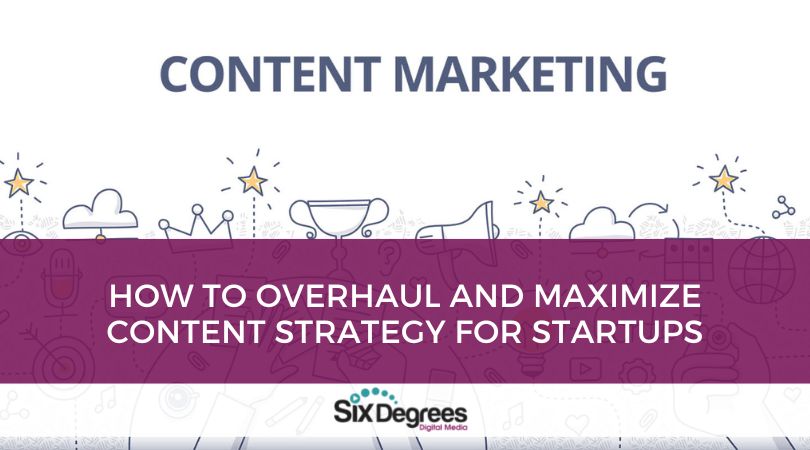Content creation eats up a lot of time, which is a limited resource for anyone building a startup. How many times have you sat down to write a piece of content and spent hours staring at a blank Google doc? It’s easy to give in and just do something else that feels more productive, but then you lose out on all the benefits that come from having a powerful content strategy for your bootstrapped startup. But don’t worry, there are some great content creation hacks that you can put in place to streamline the content creation process and maximize the results from even a single piece of content.
Mapping out a content strategy for your startup
If you’ve done your homework, then you already have some great keyword research done for your content strategy. You know what your audience is looking for and now it’s time to dazzle them with your unique take on the solution to their problems. Here is a great way to take what you know and transform it into a comprehensive content marketing plan for your startup. The best part about this strategy is that it takes an astoundingly short period of time to brainstorm every piece of content you’ll need for an entire year.
Step one: Break out the big guns
Make a list of 3 to 5 big content topics that your audience is interested in based off your research. You’re looking for umbrella categories like data security, learning online, productivity, etc. Anything that you would be able to break down into more specific topics (more on that later).
What areas are related to the problem you solve or the goal you help your customers achieve? Can you list 5 things that your ideal customer wants that are relevant to your business? What topics are your competitors talking about?
Step two: Find your subcategories
If I were creating a content map for content marketing strategies for startups, I could easily break that down into video marketing, email marketing, social media marketing, and website content. Take your initial content topics and break them down into 3 to 5 subcategories each. Online learning could become self-paced learning tips, scholarships/funding, and programs that offer online learning solutions. Productivity breaks down into time management, goal setting, and habit formation.
Each subcategory should be relevant to the main topic, while still allowing room to get more specific. Some of these things are going to be areas your customers are already searching for while others will be things they may not have thought about before. Like if I broke down the category of meals into breakfast, lunch, and dinner, but then you said “What about second breakfast?”
Step three: Create your final content topics
For each subcategory, try to list as many specific questions or topics that you can think of. What is your audience asking about these areas? What buzzwords come up? Google autosuggest can be a great way to brainstorm more of these if you’re having a hard time. You can also search for an example you have and look at the related search terms. Looking for time management pulls up suggestions like time management skills, techniques, worksheet, benefits, etc. Those are things that I can fold into what I already know about time management to create a list of great topics.
Step 4: Make it sexy
The thing about content is that nobody cares about it unless you make them care. Your ideal customer may be looking for time management tips, but if your blog is labeled “time management tips” and someone else has a blog titled “Time management tips that I used to write a book in 3 weeks”, they’re going to click on the other blog. Your blog might be a comprehensive guide that could change their life and they will just never know because the title didn’t speak to them.
Make your titles stick out by:
- Using numbers (people love a list)
- Questioning things they thought were facts
- Showing a clear benefit
- Using emotional language
- Using “how to” or other instructional language
- Not being too technical
Keep in mind that you also want to maintain a tone that is appropriate to your branding and industry. “5 time management tips you won’t believe really work (don’t do #3 in public)” may be attention-grabbing, but it also sounds like every clickbait ad ever created and that can affect your credibility.
Try out a few titles and see how they feel for your branding. Now compile everything into a spreadsheet or other document that will be easy for you and your team to follow.
Take a look at this full break down:
- Productivity
- Time Management
- How to get started with the pomodoro method of time mastery
- 3 ways you don’t even realize you’re wasting time
- Getting more done in a day – is really that important?
- 6 ways you are more productive than you think
- How the Industrial Revolution changed the way we spend our time
- Time Management
In just a couple of minutes, I’ve brainstormed 5 different topics that I can use in my startup content strategy. And that is just for one of my subcategories. Following these three steps can help you build out an entire year’s worth of content ideas in under an hour, assuming you already have a great foundation for who your audience is and how you service them.
The great thing is that we can take the list we build here and go a step further by making sure you never run out of something to say.
How to reuse your content in fresh ways
Using the example above, let’s say that I decided I would write a blog post on 3 ways you don’t even realize that you’re wasting your time. Many startup content marketing strategies would post that bad boy, push it to their socials and email list and call it a day. What a waste of great content. For the true power of content strategy, here’s what I’ll do with that topic:
- Write a 1,500-2,000 word blog post
- Create a video with the content to include on the blog page
- Create a series of three videos that I can host on YouTube, push to socials, and email
- Create a series of social media images that I can use in a carousel or individual posts
- Bundle the blog with other time management blogs I’ve written and post a master page on the topic
- Create a downloadable PDF for the master guide
- Consider creating a podcast episode
If I’m feeling frisky, I can even turn this into a masterclass and use all of the above to promote it. What a great way to warm up an audience for my imaginary startup which has developed an app to help them track their time and build better habits. I may even bundle a great deal of my content on the topic into an affordable Ebook.
One topic becomes one blog post. The copy for that post becomes at least 6 different forms of content that I can use to promote my startup and become a thought leader in my niche. Now that’s what I call the ultimate content strategy for startups.
If you spend an hour mapping your content into 100 content topics, then you could have 600 pieces of content planned for your startup. That’s not a bad way to kick off 2023. Your next step is to make sure that content is well-written and can keep your audience engaged. You definitely don’t want to write a huge blog post and chunk it into dozens of smaller content pieces just to give your audience more opportunities to ignore you.
If copywriting is not your strong suit, but you are still determined to have the best content strategy for your startup, then your best path forward is to connect with someone who understand where you are coming from and has the skills needed to make your content shine. Leave all of the heavy content lifting to the experts while you grow your startup to the next level. Snag a free content strategy session with Six Degrees Digital Media today and we will create powerful content that you can leverage to generate leads and build the brand awareness you need. Contact us today!









